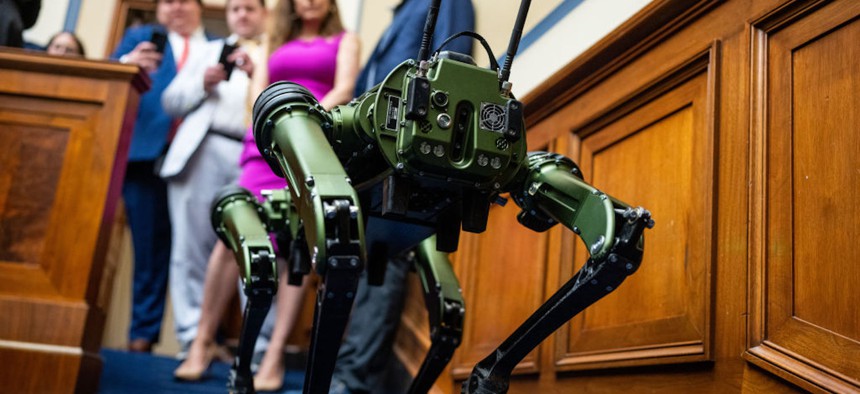
Rep. Nancy Mace, R-S.C., and staffers watch a demonstration of a Vision 60 UGV by Ghost Robotics before the start of the House subcommittee hearing on "Using Cutting-Edge Technologies to Keep America Safe," June 22, 2023. Bill Clark / CQ-Roll Call, Inc via Getty Images
Agencies get marching orders as White House issues AI-safety directive
The National Institute of Standards and Technology is ordered to draft red-teaming requirements, the National Science Foundation to work on cryptography, and the Homeland Security Department to apply them to critical infrastructure.
The White House hopes to guide how technologists develop artificial intelligence and how the government prompts and adopts AI tools, under a new executive order to be unveiled Monday.
The order lays out some basic safety rules to prevent AI-enabled consumer fraud, requires red-team testing of AI software for safety, and issues guidance on privacy protections. The White House will also pursue new multilateral agreements on AI safety with partner nations and accelerate AI adoption within the government, according to a fact sheet provided to reporters.
The order comes amid growing public concern about the effects of rapidly advancing artificial intelligence tools on public life, the future of employment, education, and more. Those concerns are at odds with warnings from key business leaders and others that China’s growing investment in AI could give it an economic, technological, and military advantage in the coming decades. The new executive order attempts to address concerns about the use of AI in dangerous settings and the misuse of AI while simultaneously encouraging its advancement and adoption.
White House Deputy Chief of Staff Bruce Reed called the order “the next step in an aggressive strategy to do everything on all fronts to harness the benefits of AI and mitigate the risks.”
On safety, the order directs the National Institute of Standards and Technology, or NIST, to draft standards for red-team exercises to test the safety of AI tools before they’re released.
“The Department of Homeland Security will apply those standards to critical infrastructure sectors and establish the AI Safety and Security Board. The Departments of Energy and Homeland Security will also address AI systems’ threats to critical infrastructure, as well as chemical, biological, radiological, nuclear, and cybersecurity risks,” according to the White House fact sheet.
The order also stands up a new cyber security program to explore how AI could lead to attacks, requires that the developers of “the most powerful AI systems” share safety test results with the government, and it calls on the Department of Commerce to develop practices for detecting AI-generated content that could be used for fraud or disinformation.
It calls on the National Science Foundation to further develop cryptographic tools and other technologies to protect personal and private data that could be collected by AI tools, and it sets guidelines to prevent organizations and institutions from using AI in discriminatory ways. It also calls on the government to do more research on AI’s effects on the labor force.
Additionally, a large portion of the order looks at how the government can better embrace AI and form new bonds and working strategies with like-minded democratic nations to do so.
“The administration has already consulted widely on AI governance frameworks over the past several months—engaging with Australia, Brazil, Canada, Chile, the European Union, France, Germany, India, Israel, Italy, Japan, Kenya, Mexico, the Netherlands, New Zealand, Nigeria, the Philippines, Singapore, South Korea, the UAE, and the UK,” the fact sheet said. The order calls on the State and Commerce departments to “lead an effort to establish robust international frameworks for harnessing AI’s benefits and managing its risks and ensuring safety.”
Still, according to the fact sheet, “More action will be required, and the administration will continue to work with Congress to pursue bipartisan legislation to help America lead the way in responsible innovation.”







